

Mechanical Systems
Mechanical systems is the study of forces and the application of forces
Mechanical Systems
Overall Expectations
By the end of this course, students will:
- describe and apply concepts related to forces, Newton’s laws of motion, static and kinetic friction, simple
machines, torques, and mechanical advantage;
- design and carry out experiments to investigate forces, coefficients of friction, and the operation of simple
machines;
- identify and analyse applications of applied forces, friction, and simple machines in real-world machines and in the human body.
The focus of this strand are forces and the application of forces via simple machines. The main headings of study are as follows:
- To start the program I will spent the openning sessions reviewing elementary math skills. Without these skills it will constantly be a struggle to achieve high marks! You will be expected to complete and hand worksheets provided and from this site.
- Review of the simple elements of motion and its components. A quick look at vectors. A board presentation.
For a set of homework questions. This is a hand in homework assignment Physics Problems for College Bound Students
Click the Leaf for assignment  Due date is September 7 2008 or Feburary 6 2009
Due date is September 7 2008 or Feburary 6 2009
The homework section is divided into colour sections (blue, green,& pink). If you need addition help come at 8:00.
A short list of definitions and a formula page may be found at 
For addition information view Div 1
- Force's and Newton's Three Laws; emphasis on the Second Law
Free body diagrams
- Friction and the Inclined Plane
- Identifying simple machines: ramp, lever, pulley will be studied in some detail
- Torques, Force and Displacement; how they are related to each other
- The Law of the Lever
- Simple machines and Mechanical Advantage; single, double and moveable pulley systems
- End-of-Unit Task: Construct a Compound Machine; eg a block and tackle
Forces in General
When we say that there is a force on an object we mean that there is a push or a pull on the
object. Some outside agent is placing this push or pull on the object.
In the metric system forces are measured in units of Newtons. This unit is named after Isaac
Newton. In the English system forces are measured in units of pounds. A Newton of force is much smaller than a
pound of force. It takes about 4.5 Newtons to equal a force of one pound. So, if you usually state your weight
in pounds, then you could figure your weight in the Newtons by multiplying those pounds by 4.5.
Forces are vectors. That is, they are quantities that have both size and direction. Forces can be symbolized with arrows,
as can all vectors. The arrow in the picture below is meant to show a force with the size of 15 Newtons directed
toward the left.
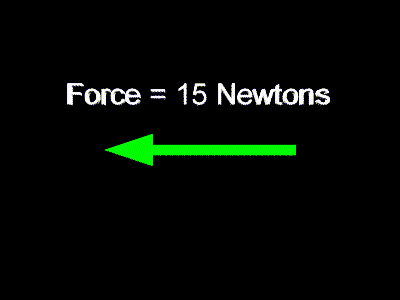
One must understand vectors
to understand forces.
Why is "Net Force" Important?
"Net force" is a central idea of dynamics. Here's why:
Newton's Laws are the big deal in dynamics. Newton's First Law can
be stated:
If the net
force on an object is zero, its acceleration
will be zero.
You will soon find out that Newton's
Second Law says:

where Fnet means "net force".
In order to use Newton's Laws, the first thing you need to know is
"What is the net force".
Finding the Net Force:
In Physics 1, you will need to be able to calculate the net force
on an object in the five situations shown below.
|
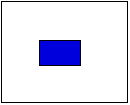
|
If no forces act on an object, the net force on the
object is zero.
Although this happens in physics problems, it is very
unlikely in practice that an object will have no forces at
all acting on it.
|
|

|
If there is just one force on an object, then that force
is the net force. In the diagram at left, the net force is 5
Newtons to the right.
For example in free fall, the net force on an object
equals its weight - the one force pulling on it.
|
|

|
If 2 forces push or pull on an object in opposite
directions, and the two forces cancel each other exactly,
the net force is zero.
|
|
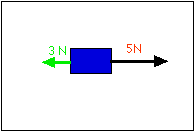
|
If two forces act on an object in opposite directions and
they don't exactly cancel, what is left over is the net
force (the difference in the forces).
In the diagram at left, the net force is 2 Newtons to the
right.
|
|
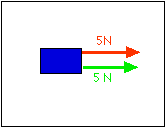
|
If two(or more) forces act on an object in the same
direction, the net force is the sum of the forces.
In the diagram at left, the net force is 10 Newtons to
the right.
|
Two additional notes may be viewed at
1.Mechanics & Forces; Working with Net Forces
Click here to view
2. Vectors in 4 parts; Introduction, Finding Components, Visualizing Components, & Component Method for Adding Vectors
Click here to view
Newton's First Law of Motion
Inertia is defined as that property of matter that resists changes to its state of motion or when it is at rest. Inertia is a resistance to a change in motion, whereas friction is a resistance to that
motion. Remember a body at rest will stay at rest, a body in motion will stay in motion, unless acted upon by some external force. This is not extremely obvious on Earth because all
motion is subject to some from of friction which is an external force an will act in opposition to any appllied force or motion. The above statment is essentially Newton's First Law of Motion.
A force is either a push or a pull.
There are two categories of forces: contact or at-a-distance. At-a-distance forces are defined as fields. Gravity, magnetic and electric fields are forces that act at a distance.
Newton's Second Law of Motion
When a force acts on an object, this object will accelerate in the direction of the applied force. As long as the force is applied the object will accelerate. A bullet fired from a rifle will
accelerate down the barrel of the rifle. Once it leaves the barrel, the applied force of the chemical explosion is not longer present and the bullet will now gradually slow down due to air resistance. Actually the bullet will either strike some object or fall to the ground long before air resistance will stop its motion. Gravity will act on the bullets vertical motion but will not effect its horizontal motion.
The mass of an object is also part of the equation. Throw a baseball then try to throw a bowling ball. Which can you throw farther? The applied force which cames from you arm muscles is
the same in both cases. The baseball will achieve a greater acceleration and travel further. The only difference if the mass of each ball.
Newton's Second Law is stated on page 108 of the text, and so is the equation theat relates the three variables; mass, acceleration, and force. F = ma. Remember that F is actually the net force acting on the object.
Another example of this concept is the difference between mass and weight.
Gravity, Mass & Weight
- Gravity
- is the force of attaction exerted by the Earth of all matter on or near the Earth.
It is an action-at-a-distance force. Units are Newtons
- Mass
- is the amount of material that makes up or is that particular object of material. The units are kilograms (kg), the SI unit. Remember to switch grams to kilograms (x1000> when converting to Newtons, a force.
- Weight
- is the force of gravity acting on a particular object or mass. Units are Newtons. A misused term in the laymans world.
To convert mass into weight multiply the mass (in kg) by the acceleration due gravity (9.8 m/s
2).
Example: What is the weight of a 6.7 kg bowling ball?
Answer: 6.70 kg X 9.8 m/s
2 = 65.66 or 65.7 N
The Law itself is simple and straight forward to use. Additions to a problem include
- determining the net force acting on the object
- resolving a force in the horizontal and vertical directions
- when masses and forces are know, these can now be used with the seven equations of motion to determine velocity and distance of an object
How to solve Math Problems will be dealt with in class.
Emphasis is on Newton's Second Law: F = ma
Newton's Third Law of Motion
Forces always occur in pairs. The action force and the reaction force. Whenever one object exerts a force on another or second object, the second object exerts a force on the first object will an equal magnitude but in the opposite direction. So who wins this apparent pushing contest? Lets look at a couple of examples.
- Take a slap shot with a hockey stick; what moves?
- With skates on stand at the boards and push on them; what moves?
- A rocket engine is ignited and rapidly expanding gases are thrust out the nozzle; both the gaes and rocket move, but in opposite directions
- While sitting in a canoe, you paddle. The paddle pushes backwards and the canoe move forward; equal forces but opposite direction
You should be able to answer "what moves" but can you explain why and what commonality exist between each answer?
Newton's Third Law is stated on page 116 of the text.
First we must look at what is called a Free Body Diagram representing all the forces acting on an object. Please note that all forces are vectors. This will be dealt with accordingly.
Vectors will be discussed as a class activity. You need a ruler and a protractor.
You will be shown how to add vectors together so that you can complete and solve free body diagrams.
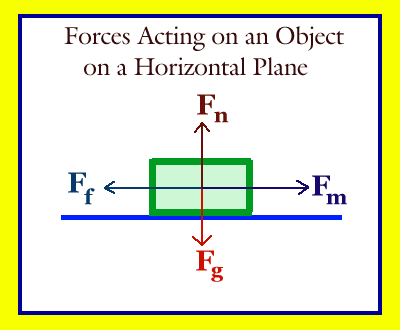
An object, either in motion or at rest on a horizonatal plane has four forces acting on it.
- Fg is the force of gravity acting on the object in a downward direction.
- Fm is the force of motion acting on this object and causing it to move with a given velocity in the same direction as the force. The object may or may not be accelerating.
- Ff is the force of friction acting between the object and the surface it is resting on. This force is always opposite to the force of motion but can never cause the object to move in a backwards direction even though it may have a value that can exceed Fm.
- Fn is the so called normal force. This is the force of the plane or surface acting upward on the block and if the object is not moving in the vertical plane, will equal the force of gravity of Fg. The normal force is always perpendicular to the surface. If the surface is horizontal Fn will equal Fg. If the surface is tilted then Fn will not equal Fg and always be less than Fg.
In this diagram the force of gravity Fg will not cause any horizontal motion.
The only applied force in this diagram is Fm. This would be the force that will produce motion in the object. Ff will oppose this motion and will cause the object to come to a stop once the applied force is removed.
Situations relating these four forces:
- If Fg = Fn the object will niether move up or down.
- If Fg > Fn the object will fall downward. Such an example would occur if placed your book on a piece of paper .
- If Fg < Fn cannot occur because Fn is a reaction force and can never be greater than Fg Note, however, that if Fg is increased Fn will also increase.
- If Fm = Ff the object will either be at rest or moving at a constant velocity. Note: at rest means the v = 0.0 m/s. In both cases there will be no acceleration.
- If Fm > Ff the object will be accelerating in the direction of this force. When this situation occurs the horizontal force are considered to be unbalanced and the object moves in the direction of the greater force.
- If Fm < Ff the object will definitely be at rest or slowing down if the object was origonal in motion. Ff will be studied on its own under the concepts of coefficient of friction.
Coefficient of Friction
- The force of friction appears to be approximately the same different low speeds.
- The force of friction does not depend strongly on the area of contact between clean uniforn surfaces.
- The force of friction is directly proportional to the perpendicular force (the normal) pressing the two surfaces together.
- Starting friction is somewhat greater than moving friction. Remember that inertia must be overcome to start an object moving.
If the plane is not in the horizontal position but is inclined then the acting forces on the object interact with each other in a more complex manner.
In this situation the force of gravity Fg will influence the motion of the object down the inclined plane.
Here's a diagram of the forces acting on an object sitting on an inclined plane.
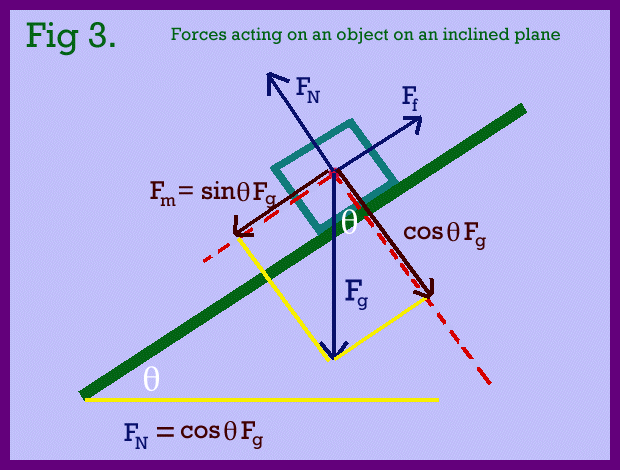
The dynamics of this object will be a function of the angle of inclination, the surfaces in contact with each other as measured by the coefficient of friction, the mass of the object, that is Fg and any applied force, Fm. These relations will be discussed in class, with an appropriate board note.
If the object is just about to move the angle θ is called the angle of repose
Information relating to our experiments
In the experiment investigating a block sliding down an inclined plane the relationships studied are
- Surface area contact
- Types of material or surfaces in contact
- Mass of block
Since the experiment was done qualitatively (no numbers or measurements), of the three variables it appeared that only type of material effected the ability of the block to slide down an inclined plane. Both surface area and mass did not change the angle of repose.
In the second experiment, with the same block will be pulled on a horizontal surface. In the class experiment the force required to overcome static friction and the force required to overcome kinetic friction (& keep the block) moving will be measured for four different masses. Mass must be changed to force in the calculations and graphings.
The starting force required to just get the block moving is related to static friction and the force to keep the block moving is related to kinetic friction is to be plotted against the different masses (Fg) and the slope of the line is to be determined. This slope is the coefficient of friction. The slope will be non zero and usually less than 1. There is no units to this slope. 
In the third experiment the coefficient of Sliding Friction will be determined.
This relates directly to the diagram above seen here as a thumbnail.
For more information on Force, Newton's Laws of Motion, Friction, and Mass & Weight then just
Click Here
A third hand in homework assignment  Due date : September 28 or February 25
Due date : September 28 or February 25
Section 2

Machines, Work, & Mechanical Advantage
A machine is a device designed to make "work" easier or in some cases possible for a preson to do. If you have a flat tire you cannot lift your car, however using a car-jack or screwjack enables you to raise the car and change the flat. Also, you cannot remove the wheel nuts without a tire wrench. These are examples of machines. Here are pictures of 6 simple machines.
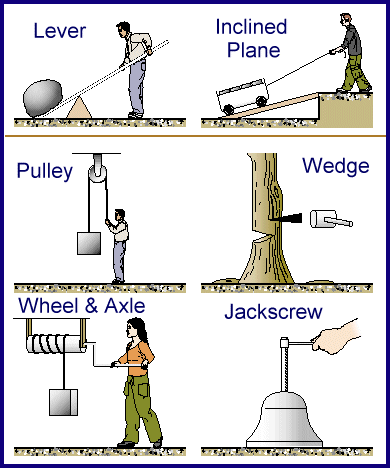
Some machines change one force into another, others transfer force from one place to another or cause an applied force to have its direction changed. Machines can amplify a force or decrease its size. You should and remember examples of each of these different machines.
One thing a machine cannot do: make energy. Machines change amplify but do not produce more energy than what can be inputed.
How is work and force related?
Work and Force
- Work is the energy required to cause an object to move. Work is done when an object is moved a given distance. If the object does not move then no work is done, even though energy is applied. An example of this is you pushing on a wall, just because you apply a force, the wall does not move hence no work is done.
- Another way of saying the same thing: a force when applied to an object may or may not cause the object to undergo an acceleration. If an onject undergoes a change in motion i.e. it is accelerated then work is done on the object. Remember Newton's First Law: An ojbject in motion will stay in motion unless acted upon by a force. On Earth this force is usually friction which acts in the opposite direction of the motion.
- The units for work is the joule. This is the same unit as for energy.
- Work is mathematically calculated by multiplying the force times the distance the object moves. The force and the direction of the motion must be in the same direction. Pushing an object acoss a floor will not cause it to be lifted.
- The mathematical is W = Fd
- This equation is key to understanding why a machine makes a job or "work" easier. Machines can change the value of the applied force making the effort involved easier. For example it is easier to push an heavy load up a ramp than to lift it directly upward. A screwjack easily will lift a car, something you could not do without a machine.
- Important: machines change or alter forces not work
Since work is applied energy, it cannot be created, but you can alter the effort required to do that work. Explination via examples to follow in class
Two additional notes that are required readings
- Click Here A short note is give for each of the simple machines
-
Click Here Other machines are shown here that you should be familiar with.
The Inclined Plane or Ramp
The inclined plane is a simple machine that allows large objects to be raised against the force of gravity, with less work than needed to directly lift the object.
An experiment will be done to confirm this concept. A mass will be lifted a given distance and the work calculated to do so. The same mass will be pulled up a ramp and the work required determined. The two values will be compared.
This leads to the concept of mechanical advantage. In each case the amount of energy is the same, however the force or effort can be manipulated. This is what a machine does best. The actual mechanical advantage of any machine is the ratio of the magnitude of the force required to lift the load vertically (the load force) to the magnitude of the force necessary to move the object by the machine doing the work.
Determining the efficiency of a machine, use the formula
load force Fg
MA = ---------- = -------
applied force Fa
Levers and Pulleys
A lever consists of a rigid bar that can rotate about a fixed point called a fulcrum There are three classes of levers which depent on the position of the load to applied force to fulcrum. Make sure you can define each. Pictures are shown below
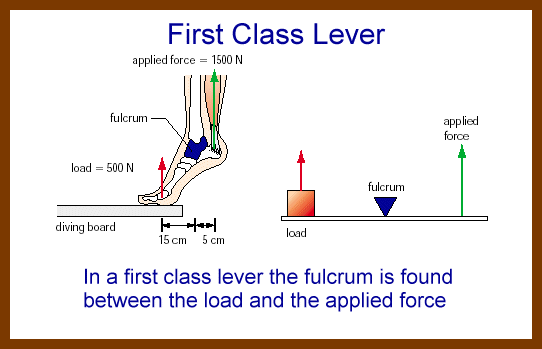
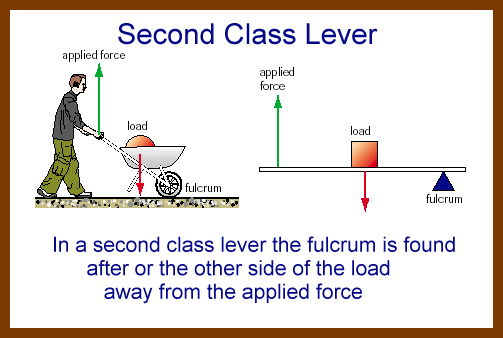

The turning effect of a force on a lever is called Torque. It is defined to be the product of the force and the perpendicular distance from the axis of rotation to the application of the applied force or the load.
This perpendicular distance is called the lever arm (l) . Torques has units of newton-meters but is not really considered to be work. The torque applied to one side of a lever must equal the torque on the other side of the lever. Since torque equals F x l, determing an applied force for a lever can be computed. Problems to be done in class.
Class picture of lever lab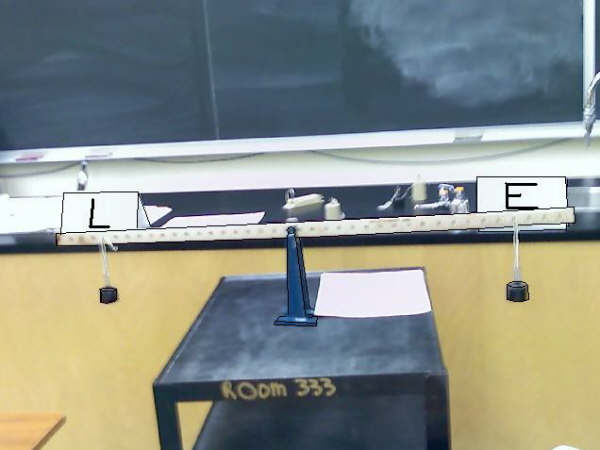
Pulleys are another of the simple machines. Pulleys trade distance for effort so as to make lifting a heavy object easy that is, the applied force can be reduced. Examples of pulley systems are shown below.
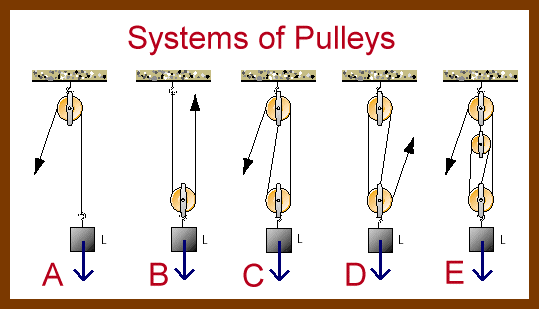
For You: determine the mechanical advantage of each of these systems
-
-
-
-
-
To see pulleys in action where you select the number of pulleys, either two, four, or six
Click Here From the ThinkQuest Library
A simple lab activity is carried out, in which you build the pulley system and compare the effort force to the load and the distance the load is raised to the distance pulled by the effort. Machanical advantage can then be determined.
Two note on machines and there properties. The second note is an extention of the first note.
NOTE #1 DIV 5
NOTE #2 DIV 6

Homework from the text book
Page 65 # 7
Page 66 #9, 10
Page 68 #13, 14
Force & Motion work sheet; requires motion equations to complete all the questions.
DIV 1
Hints when working with motion equations
These problems tend to be
layered, that is multiple steps are required, several formulae are to be used in conjunction with one another.
A few common sence points
- problem analysis is an absolute must!
- rest means that the velocity is 0.00 m/s. An object can start from rest v1 = 0.00 m/s or it may come to rest, it is stopping, therefore v2 = 0.00 m/s.
- A positive force will cause the acceleration to be in the direction of the motion and either keep the object moving at a constant speed or cause the object to speed up.
- A negative force will cause the acceleration to be in the opposite direction of the motion. This will cause the object to slow down and eventually come to rest or stop.
- Vector diagrams or free-body diagrams will assist you in sorting out the forces acting on an object. Accurately drawn diagrams will enable you to sove problems without using triginometry (Laws of Sines and Cosines)
- Subtracting the second or final velocity (v2) from the first or initial velocity (v1) and dividing by the time it takes the object to change velocity will yield the acceleration (Units are m/s2)
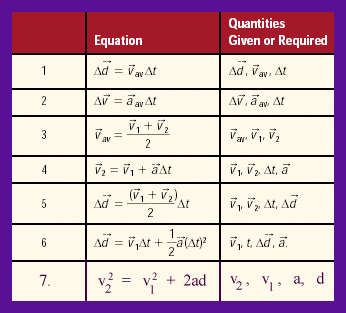 These are the equations that you must be familiar with. For a set of homework questions
These are the equations that you must be familiar with. For a set of homework questions  Click the Leaf
Click the Leaf
- Remember that the mass can be changed into a force by multiplying the mass by 9.80. Please note that this force only acts in the downward direction or [S] in a vector diagram. A normal force will always be equal to this but opposite in direction.
Test Information
- A vector addition question
- Find the acceleration given the mass and force, find the force given the mass and acceleration. Formula F = ma
- Find the acceleration given the initial & final velocity with the time interval.
- Find the required or applied force to an object of given mass when the acceleration is not given but must first be calculated from the initial, final velocities, given also the time interval
- Assessment categories K/U (22) and Comm (10)
- Done reasonably well by most people
Homework Assignment #3
Homework based on Inclined Planes and Coefficient of Friction
Third hand in Assignment
- A 20 kg pile of books is resting on a plank so that it makes an angle of 20o with the ground. What is the normal force?
- How much force is needed to keep a 62 kg crate moving across a floor at a constant speed if the kinetic coefficient of friction between the floor and the crate is 0.18?
- A 45 kg table can be pushed along the floor at a constant speed with a force of 170 newtons. What is the coefficient of friction (μ) between the table and the floor?
- A force of 40.0 N is needed to push a wagon up a 35o slope. What is the mass of this wagon? (Case 1 neglect friction.)
Bonus: Case 2: The coefficient of friction between the wagon and the ramp (slope) is 0.0872
- You have a rope attached to a cart the weighs 450 newtons,and you are lowering the cart down a 25o slope. If the friction is 75 N, how hard do you have to pull on the rope to prevent the cart from running away from you? (Make sure you know what the physics of "run away from" means.)
Also, find the angle of repose for this cart.
- A 45 kg load is on a ramp inclined at 38o to the horizontal, and the coefficient of friction between the load and the ramp is 0.26. Find the following
- the force that would be needed to push the load uphill if there were no friction;
- the normal force that the load exerts on the ramp;
- the force of friction;
- the actual force that would be needed to move the load up the ramp.
Answers to the above question may be found at
Click Here
DIV 5
The Lever and Mechanical Advantage
A lever consists of a rigid bar that can rotate about a fixed point called a
fulcrum. There are three classes of levers depending upon where the load, effort and fulcrum are positioned relative to each other. (See above diagrams and those sketched in class).
In this picture the effort is on the left and the load is on the right. Note the various ratios of effort to load, distance ratios and arc length ratios.
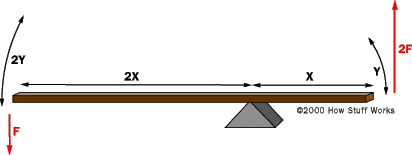
The turning effect of a force on a lever is called torque. When a lever is in the balanced position, the clockwise torque will equal the counterclockwise torque. This is called the law of the lever.
The magnitude of the torque symbol τ is calculated by multiplying the force applied (either load or effort) by the perpendicular distance of the force from the fulcrum. The perpendicular distance is called the lever arm l. The unit for torque are newton-meters (N-m)
Experiments are to be done in class to verify this law and to measure the Mechanical Advantage MA of a lever system.
There are two types of mechanical advantage:
- Ideal mechanical advantage which ignores friction and is based on distances.
- Actual mechanical advantage which incorporates friction, based on the forces used, ie, effort and load.
Which one do you use: read the problem, it will tell you. Sometimes you calculate
IMA and then calculate
AMA
Both
IMA or
AMA are the ratio of the load force to the applied force or F
g to F
a.
The efficiency of a machine is the ratio of useful work done to actual work done. In most machines incolving motion effort muct be applied to overcome friction. This causes the machine's useful work to be less than the applied work. In the example of pushing a crate up a ramp the ramp makes the effort easier but frictional forces require extra effort.
For more information go to DIV 6
Simple Machines Group Project
Since there are 25 students and seven simple machines the groups will be divided into groups of three or two.
This semester Fall 2008 there will be no presentation or model building so ignor all references to either presentations or model building. Instead of the model a large diagram will be required showing all forces acting as the machine is in action and how these forces are related in appropriate equations.
The following is a
suggested student designations:
- A team captain or coordinator
- A chief writer
- A major presentor
- The model builder or diagram artist who preforms the actual use of the machine showing all measurements related to the action of the machine.
Mechanical Advantage
Introduced on Sept 23 with groups being assembled
Due on Sept 29. You cannot be late or expect and extention.
Class research time will
NOT be provide
Requirements
- A short essay or report on your machine 400 - 800 words, a description of the machine.
- Purpose and main uses of your machine; situational examples as to where and why your machine is used
- How the machine is constructed and materials or parts needed in its construction
- Concise references to effort force Fe, effort distance de and load force FL , load distance dL
How these four variable relate in a formula
- Explain what mechanical advantage is and how it can change as variables in machine construction are changed
- How IMA and AMA are determined, make sure you use some real numbers to show calculations (you must think your way through this step).
- Show, explain how to determine the efficiency of your machine with a numerical example.
- Examples of your machine in the home and in industry
- A couple of examples of your machine being used in conjunction with other simple machines; name the device, gaget or piece of equipment that uses these machines in tandem with each other.
Further Instructions
- Diagram of the machine must be large enough to seen in a classroom presentation
- Your built machine should be able to carry out the require function of that machine
- You must use actual numbers and measurement to show the Mechanical Advantage of your machine
- Presentation board is optional
- Written report is NOT a print out from some Internet site.
- A bibliography is required or the report will not be evaluated
The Groups:
Have been assigned in class
Report any group member that is a "slacker". I'll try to help motivate this individual.
Independent Research Project
In this assignment you will be asked to investigate how science (in our case the theory and appliction of simple machines) is used in technologies to improve society and human development.
Write a short essay relating machine technology to societal improvement under these headings:
- Name three machines (inventions) that changed the course of history and the societal developements that ensued.
- How do machines make life easier for humanity in general.
- Describe the role of machines in everyday domestic life and in industry.
- Give examples where the use of a machine may not be benificial or has actual detrimental value to society.
- Identify simple machines that are part of a device used at home and explain the function of each machine.
You must discuss three examples.
- Explain the benefits and detriments of "automation". (The use of machines to do everything).
Done in conjuntions with your machine essay hence date due is the same
A Making Connections activity with a communication mark.
Hints:
- Start right away
- Use the Internet
- Make sure you actually select a "machine". For example, the microscope would not be defined as a machine, it does no work.
- Ask questions in class
The following site may be helpful in getting started and/or reviewing simple machinesClick Here
DIV 6
Machines
Fundamental Types of Machines
The six (seven) simple machines can be catorgized into two modes:
- the lever which include the pulley, wheel and axle and gears
- the inclined plane which include ramps, the wedge, and screw
- Machines are devices can be used to transform energy from one form to another such as an car engine turns chemical energy stored in gasoline into mechanical energy.
- Machines are also used to transfer energy from one place to another.
Remember, a machine cannot create energy or work
A bicycle sprocket and chain transfers energy from the pedals to the back wheel.
- Another use for machines is to multiply force. In any system energy must be conserved, however, force may be manipulated
- Machines are used to change the direction of a force, which may make the task easier for a person to preform. For example, sometimes its easier to pull than to push.
- Machines make a human chore easier or in some cases possible, for example you cannot lift a car up to change a tire with the use of a machine.
Moments or Torque
The turning effect produced by a force acting on an object free to rotate about a point of support is called its
moment about that point or
torque. The magnitude of this moment depends on two factors : the magnitude of the applied force (load or effort) and its distance from the point of support. This means that the torque or moment about a point is the product of magnitude and distance: Torque = F x d . This torque may be in either a clockwise or counterclockwise direction. The units for torque is the newton-meter (N-m).
Torque will occur on both sides of the fulcrum of a lever, but in opposite directions. Motion will occur on the side with the greatest torque and if the torque is equivalent on both sides of the fulcrum motion will not occur and all forces will be balanced or in equilibrium.
Mechanical Advantage
The force applied to a machine is understood to be the force the the operator applies to make the machine work. This force is frequently called the
effort.
The force moved at the "other end " of the machine is refered to as the
load or resistance. Remember, a mass when moved becomes a force (F = ma)
During the operation of a machine both the applied force, effort, and the load are displaced. The
ideal mechanical advantage of a machine is the ratio of the distance that the effort moves to the distance theat the load moves. Since friction always occurs from the contact of moving parts,the
actual mechanical advantage is somewhat less than the ideal mechanical advantage and can be determined as the ratio of the load to the applied
force F
L to F
E.
Efficiency of Machines
The fundamental purpose of any machine is to do useful work. In order ot do work the machine must be supplied with energy. If all this energy is converted into useful work this would be an ideal machine with an efficiency rating of 1 or 100%. Since energy is always lost in a machine to other nonuseful forms of energy such as sound, heat, or friction, no machine actually converts all its inputed energy or work to useful or actual work done. The
efficiency of a machine is evaluated as the ratio of useful work done by the machine to the work or energy supplied to operate the machine. There are several versions of efficiency equations which will be discussed in the lesson.
Efficiency may be determined as the ratio of actual mechanical advantage to ideal mechanical advantage.
© R. Warren Sept 2002
 Due date is September 7 2008 or Feburary 6 2009
Due date is September 7 2008 or Feburary 6 2009

















